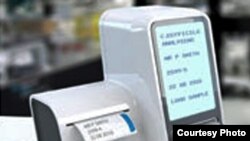Bladder cancer is the ninth most common cancer in the world, with an estimated 12 million new cases diagnosed annually. Now, researchers have developed a “scent device” that accurately diagnoses the disease in virtually all people with bladder cancer.
The device, called OdoReader, contains a sensor that detects chemicals in the gases emitted by urine.
In about half an hour, the device can analyze the odors in a urine sample, telling researchers whether the patient has bladder cancer.
Chris Probert is with Britain's University of Liverpool. He was part of a team that tested OdoReader, developed by the University of the West of England’s Institute of Biosensor Technology in Bristol.
Probert says the device’s results, read by a computer, are highly accurate.
“This data set is very strong: 96-100 percent accuracy. We think we are right for the next study to show that it is reproducible and then, hopefully, we can talk to industry about making a box that people can buy for use in surgeries and hospitals," said Probert.
Researchers tested OdoReader on 98 urine samples. Two dozen were from patients with known bladder cancer, and 74 came from those who had bladder infections, but no cancer. The device correctly identified all of the bladder cancer patients.
Probert says researchers in other labs are developing sniffing devices to diagnose stomach cancer, another extremely common disease worldwide.
Investigators liken OdoReader to a dog's nose. An earlier study showed that dogs could be trained to detect bladder cancer based on odor in urine. However, their accuracy was not nearly as reliable as the new device.
Probert foresees a time when the scent device could be used to monitor the health of workers in certain industries, such as rubber and insulation manufacturing.
“There’s quite a burden of cancer in those employees. And so, occupational health in those places of work could help their employees by taking a urine sample, much as they are doing now but with much more accuracy with our machine," he said.
Currently, bladder cancer is detected by looking for the presence of blood in the urine.
Probert says investigators have not yet identified which gases in urine make the scent unique to bladder cancer. But he says that work is coming, along with other odor reading devices that use unique scent signatures to diagnose a variety of cancers, including those of the uterus and colon.
An article by Chris Probert and colleagues on the OdoReader in the detection of bladder cancer is published in PLoS ONE.
The device, called OdoReader, contains a sensor that detects chemicals in the gases emitted by urine.
In about half an hour, the device can analyze the odors in a urine sample, telling researchers whether the patient has bladder cancer.
Chris Probert is with Britain's University of Liverpool. He was part of a team that tested OdoReader, developed by the University of the West of England’s Institute of Biosensor Technology in Bristol.
Probert says the device’s results, read by a computer, are highly accurate.
“This data set is very strong: 96-100 percent accuracy. We think we are right for the next study to show that it is reproducible and then, hopefully, we can talk to industry about making a box that people can buy for use in surgeries and hospitals," said Probert.
Researchers tested OdoReader on 98 urine samples. Two dozen were from patients with known bladder cancer, and 74 came from those who had bladder infections, but no cancer. The device correctly identified all of the bladder cancer patients.
Probert says researchers in other labs are developing sniffing devices to diagnose stomach cancer, another extremely common disease worldwide.
Investigators liken OdoReader to a dog's nose. An earlier study showed that dogs could be trained to detect bladder cancer based on odor in urine. However, their accuracy was not nearly as reliable as the new device.
Probert foresees a time when the scent device could be used to monitor the health of workers in certain industries, such as rubber and insulation manufacturing.
“There’s quite a burden of cancer in those employees. And so, occupational health in those places of work could help their employees by taking a urine sample, much as they are doing now but with much more accuracy with our machine," he said.
Currently, bladder cancer is detected by looking for the presence of blood in the urine.
Probert says investigators have not yet identified which gases in urine make the scent unique to bladder cancer. But he says that work is coming, along with other odor reading devices that use unique scent signatures to diagnose a variety of cancers, including those of the uterus and colon.
An article by Chris Probert and colleagues on the OdoReader in the detection of bladder cancer is published in PLoS ONE.




